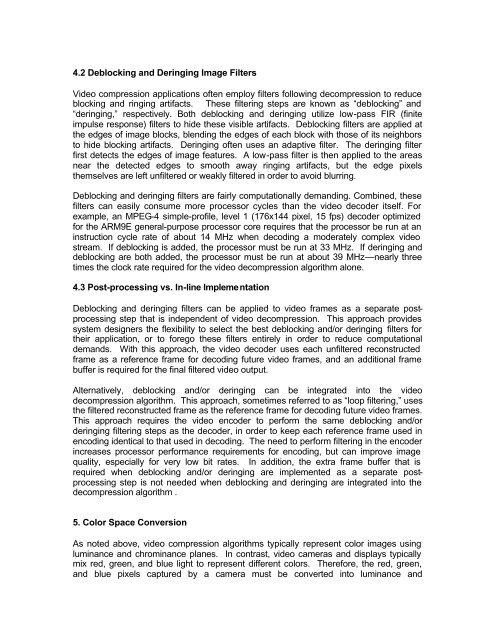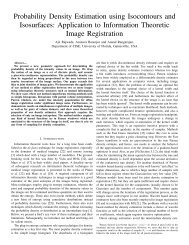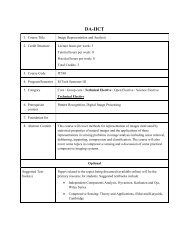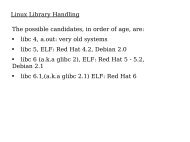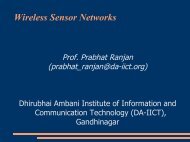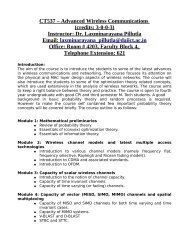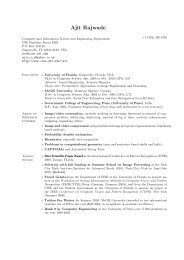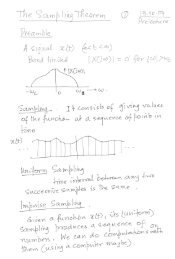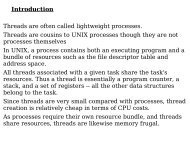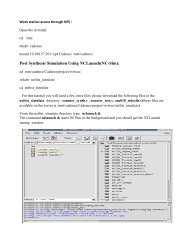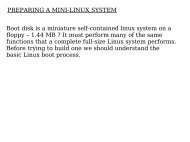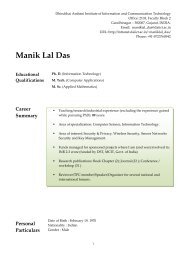ESC-210: Introduction to Video Compression - DAIICT Intranet
ESC-210: Introduction to Video Compression - DAIICT Intranet
ESC-210: Introduction to Video Compression - DAIICT Intranet
You also want an ePaper? Increase the reach of your titles
YUMPU automatically turns print PDFs into web optimized ePapers that Google loves.
4.2 Deblocking and Deringing Image Filters<br />
<strong>Video</strong> compression applications often employ filters following decompression <strong>to</strong> reduce<br />
blocking and ringing artifacts. These filtering steps are known as “deblocking” and<br />
“deringing,” respectively. Both deblocking and deringing utilize low-pass FIR (finite<br />
impulse response) filters <strong>to</strong> hide these visible artifacts. Deblocking filters are applied at<br />
the edges of image blocks, blending the edges of each block with those of its neighbors<br />
<strong>to</strong> hide blocking artifacts. Deringing often uses an adaptive filter. The deringing filter<br />
first detects the edges of image features. A low-pass filter is then applied <strong>to</strong> the areas<br />
near the detected edges <strong>to</strong> smooth away ringing artifacts, but the edge pixels<br />
themselves are left unfiltered or weakly filtered in order <strong>to</strong> avoid blurring.<br />
Deblocking and deringing filters are fairly computationally demanding. Combined, these<br />
filters can easily consume more processor cycles than the video decoder itself. For<br />
example, an MPEG-4 simple-profile, level 1 (176x144 pixel, 15 fps) decoder optimized<br />
for the ARM9E general-purpose processor core requires that the processor be run at an<br />
instruction cycle rate of about 14 MHz when decoding a moderately complex video<br />
stream. If deblocking is added, the processor must be run at 33 MHz. If deringing and<br />
deblocking are both added, the processor must be run at about 39 MHz—nearly three<br />
times the clock rate required for the video decompression algorithm alone.<br />
4.3 Post-processing vs. In-line Implementation<br />
Deblocking and deringing filters can be applied <strong>to</strong> video frames as a separate postprocessing<br />
step that is independent of video decompression. This approach provides<br />
system designers the flexibility <strong>to</strong> select the best deblocking and/or deringing filters for<br />
their application, or <strong>to</strong> forego these filters entirely in order <strong>to</strong> reduce computational<br />
demands. With this approach, the video decoder uses each unfiltered reconstructed<br />
frame as a reference frame for decoding future video frames, and an additional frame<br />
buffer is required for the final filtered video output.<br />
Alternatively, deblocking and/or deringing can be integrated in<strong>to</strong> the video<br />
decompression algorithm. This approach, sometimes referred <strong>to</strong> as “loop filtering,” uses<br />
the filtered reconstructed frame as the reference frame for decoding future video frames.<br />
This approach requires the video encoder <strong>to</strong> perform the same deblocking and/or<br />
deringing filtering steps as the decoder, in order <strong>to</strong> keep each reference frame used in<br />
encoding identical <strong>to</strong> that used in decoding. The need <strong>to</strong> perform filtering in the encoder<br />
increases processor performance requirements for encoding, but can improve image<br />
quality, especially for very low bit rates. In addition, the extra frame buffer that is<br />
required when deblocking and/or deringing are implemented as a separate postprocessing<br />
step is not needed when deblocking and deringing are integrated in<strong>to</strong> the<br />
decompression algorithm .<br />
5. Color Space Conversion<br />
As noted above, video compression algorithms typically represent color images using<br />
luminance and chrominance planes. In contrast, video cameras and displays typically<br />
mix red, green, and blue light <strong>to</strong> represent different colors. Therefore, the red, green,<br />
and blue pixels captured by a camera must be converted in<strong>to</strong> luminance and


